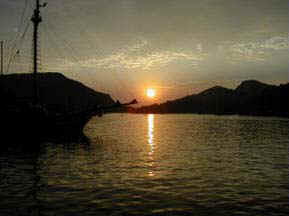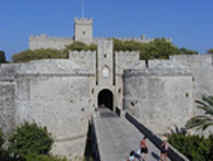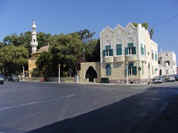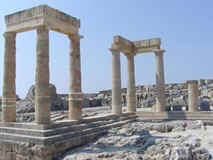 ® ® 
 Rhodes
Island Rhodes
Island
Rhodes is the largest of the
Dodecanese islands and one of the largest in the Aegean sea. It is
situated approximately 17,7 km from the coasts of Turkey. The population
is about 130.000 persons , of which approximately 60-70.000 reside in
the city of Rhodes. Rhodes called from its local people the Rose of the
Aegean and deserves its name because is one of the most beautiful Greek
islands. Rhodes has the oldest tourist history from all the islands of
Greece . Rhodes town is divided to the new town and the old town from
the big medieval wall. The beauty of Rhodes town is the old town with
the medieval castles ,houses and streets. At the port the visitor will
find Mandraki with its circular Market and the Cafes at the seafront
,further on are the Art Deco buildings of the Metropolis from the times
of the Italian occupation. At the entrance of the port are the famous
two columns with the two Deers at the place where supposed to be the
colossus of Rhodes .The ancient city of Lindos is another of the main
Attractions of the island.
- HISTORY
OF RHODES
Rhodes was inhabited at the
Neolithic era. In 322BC, Rhodes was joined with the empire of
Alexander the Great. After his death , Rhodes maintained in close
trade with the kingdom of Ptolemy's in Egypt. In 164BC, Rhodes
signed a treaty with Rome. At the first century of our era,St Paul
visited the island. Between 1307 and 1522, the island was the seat
of the order of Knights of St John of Jerusalem. The Knights
occupied Rhodes in 1307 and completed the conquest in 1310 . They
strengthened the city, leaving the Great current walls. In the low
part of Rhodes, they built the palace of the Great Master . The
island was a first seat in 1480, before falling to the hands from
the Turks from Soleiman the Magnificent in 1522, after a five month
siege. In 1912, Italy seized the island which belonged to the Turks
then. The island reunited with Greece in 1948.The Colossus of Rhodes
After defeating Demetrius Poliorcetes in 305 BC, the citizens of
Rhodes used their booty to erect a thank offering to their divine
patron Helios. Chares of Lindos, a pupil of Lysippus, built (292-280
BC) a bronze statue of the nude young god wearing a sun-ray crown
and looking out to sea. Many stories exaggerate the size of the
statue; it must, however, have been approximately 36 m (120 ft) high
on a base of white marble 6-7.5 m (20-25 ft) high and thus larger
than any other statue. It stood beside, not over, the harbor.
Although reinforced with stone and iron, the Colossus broke at the
knees and fell in an earthquake 60 years later. It remained a wonder
until the Arab invasion (AD 653), when it was broken up and sold for
scrap metal. Nothing of it remains except very dubious copie.
- SITES TO VISIT IN
RHODES The
Medieval City - New
Town - Lindos
The
Medieval City
 During
the 14th and 15th centuries the Knights of the Order of St. John
extended the Byzantine city and reinforced its fortifications creating
the medieval town of Rhodes. Of note is the architecture in the gothic
style developed in Provence at the Papal Court of Avignon (1309-1424)
with which the Knights maintained close ties. During
the 14th and 15th centuries the Knights of the Order of St. John
extended the Byzantine city and reinforced its fortifications creating
the medieval town of Rhodes. Of note is the architecture in the gothic
style developed in Provence at the Papal Court of Avignon (1309-1424)
with which the Knights maintained close ties.
Eleven gates provided access to the city which is divided into two
parts: The Collachium, where the Knights resided - the most impressive
buildings from that time are located here: the Grand Master's Palace,
the Infirmary and the Langues - and the Burgo, the main town.
The Old Town, as the locals call it, is today one of the best preserved
fortified medieval towns and has been listed by UNESCO and a world
cultural heritage monument. Walking down its paved streets, admiring the
imposing Knightly buildings, the walls and their dry moat and the
bastions, the Byzantine churches and the mosques, the squares, gardens
and courtyards of houses, the visitor feels that time has stopped while
at the same time discovering that this unique town is still living, full
of surprises and just asking you to explore it.
The Knights' Street (Odhos Ippoton) is 200 m long and 6 m wide. It was
the main official street connecting the religious and political centre
of the fortress, in other words the Catholic Cathedral (Panaghia
Kastrou) and the Palace of the Grand Master. Along its length are the
most important public and private buildings erected by the Knights.
Here, with few exceptions, is the accommodation for the Knights, the
"Langues", the national divisions of the Order of the Knights
of St. John. The street is inclined and unusually for a medieval city
completely straight. That is one indication that it was first marked out
in antiquity. This was retained by the Knights precisely because the
strict linear layout suited them and the new political importance they
attached to it.
Visit the Clock Tower built in 1851 which was once used as lookout post.
It has a small collection of archaeological finds discovered there. The
view of the Old Town from the tower is breathtaking.
Panaghia Bourgou is a late gothic church dating from the 14th century.
It was bombed during World War II and today the three apses of the
sanctuary are what remain.
Sokratous St. ends in Ippokratous Square. It is the main commercial
street in the Old Town. Around the square with its large fountain are
many bars, restaurants and nightclubs.
Of the many impressive mosques in the Old Town the Suleyman Mosque is
truly noteworthy. The present-day building was constructed in the 19th
century on the site of an older one which tradition says was erected by
the town's conqueror Suleyman the Magnificent. Note the intricate marble
entrance which comes from a grave monument from the time of the knights.
In Dorieon Sq. lies Retzet Pasha Mosque.
New Town
 The
Temple of Aphrodite from the 3rd century BC. Its ruins were unearthed in
the heart of the new town between Mandraki and Akandia Port in Symi
Square. The
Temple of Aphrodite from the 3rd century BC. Its ruins were unearthed in
the heart of the new town between Mandraki and Akandia Port in Symi
Square.
Murat Reis Mosque with its elegant minaret lies near the Prefectural
Building. It is built on the site of Aghios Antonios Church next to the
Knight's Cemetery. The Turkish cemetery contains the tombs of exiled
Turks, an admiral of Suleyman II's fleet in a round mausoleum and a poet
banished by the Sultan for his sarcastic poetry. In the square around
the mosque the ruins of the ancient walls have been found together with
inscribed stone balls marked with their weight. They begin at 5 mnes and
reach 10 talents (2 to 261 kilos approximately). From the type of
letters the balls have been dated to the famed siege by Dimitris
Poliorcetes. Aghios Nikolaos lighthouse is a fortress at the end
of the jetty with the same name where the deer statutes stand at the
entrance to the port welcoming visitors to the island.
At the other end are three windmills. The first houses the offices of
the Army Hydrographical Service where maritime maps can be purchased.
The second from the 15th century operates as a museum. One can see the
grinding mechanism while the third houses a travel agency.
Aghios Stefanos Hill also known as Monte Smith after an English admiral
of Napoleon who called at the island in 1802. In the well laid out and
verdant archaeological park are the surviving remains of a 3rd century
BC Stadium where the Alies Games were held, the largest celebration for
the Ancient Rhodians in honour of the god Helios.
Next to the stadium a small, marble open-air theatre has been restored
and is used for musical performances just like in antiquity.
At the peak of the hill is the temple of Apollo Pythia, protector of the
city. From here the view over the town and the sea is panoramic and the
sunset enchanting.
The tombs of St. John are in the central part of the extensive Rhodian
necropolis. Important monuments are the large corner tomb complex with
domed graves, the group of domed graves crowned by a monument with
triglyphs and metopes and the tomb carved into the rock with a
monumental gateway. Of most interest is the underground quarry into
whose tunnels grave chambers were dug.
LINDOS
 Lindos
(46 km from Rhodes town) Lindos
(46 km from Rhodes town)
The listed village of Lindos has preserved its architectural uniqueness
as well as its traditional decoration. White, boxy houses with flat
roofs, imposing entrances leading into courtyards filled with flowers
accessed along pebbled streets are situated around a sheltered port and
lead up to the acropolis. The climb is via picturesque narrow streets on
foot or on Lindos 'taxi', donkeys.
The acropolis of Lindos is built on a precipitous rock soaring 116 m and
dominating the village. It is a real balcony with a view over the sea.
The monuments there are evidence of the power and wealth of Lindos over
the ages.
|


 Rhodes
Island
Rhodes
Island During
the 14th and 15th centuries the Knights of the Order of St. John
extended the Byzantine city and reinforced its fortifications creating
the medieval town of Rhodes. Of note is the architecture in the gothic
style developed in Provence at the Papal Court of Avignon (1309-1424)
with which the Knights maintained close ties.
During
the 14th and 15th centuries the Knights of the Order of St. John
extended the Byzantine city and reinforced its fortifications creating
the medieval town of Rhodes. Of note is the architecture in the gothic
style developed in Provence at the Papal Court of Avignon (1309-1424)
with which the Knights maintained close ties. The
Temple of Aphrodite from the 3rd century BC. Its ruins were unearthed in
the heart of the new town between Mandraki and Akandia Port in Symi
Square.
The
Temple of Aphrodite from the 3rd century BC. Its ruins were unearthed in
the heart of the new town between Mandraki and Akandia Port in Symi
Square. Lindos
(46 km from Rhodes town)
Lindos
(46 km from Rhodes town)